Table of Contents
ToggleI remember the first time I stepped into a space that felt truly welcoming—a place where warmth met function. The room wasn’t just a cooking area; it was the heart of the home, blending rustic charm with modern ease. That moment sparked my love for designs that tell a story.
Creating this look isn’t about perfection. It’s about curated imperfections—reclaimed wood floors, glass-front hutches, and a mix of old and new. Designers like Rikki Snyder and Christopher Horwood showcase how freestanding pieces and natural materials bring character to any space.
In this guide, I’ll share 13 ideas to transform your space. From color palettes to layout tricks, each tip balances practicality with charm. Whether you love vintage touches or sleek finishes, you’ll find inspiration to make your home feel uniquely yours.
1. Embrace the Charm of a Farmhouse Cottage Kitchen
The scent of aged wood and fresh herbs greeted me as I walked into a space that felt instantly familiar. It wasn’t just a room—it was a living story, where every scratch on the table and patina on the cabinets added depth.
Why This Style Feels Like Home
Unlike sterile modern designs, this aesthetic celebrates imperfections. My first time cooking here, I noticed how the thick oak countertops absorbed the warmth of the stove. It felt like the room had been loved for decades.
Key Elements That Define the Look
Five details create this timeless personality:
- Natural materials: Reclaimed beams, stone sinks, and unfinished wood.
- Soft curves: Round-edged tables and apron-front sinks.
- Visible history: Distressed finishes and vintage hardware.
- Functional storage: Open shelves for daily-use items.
- Layered textures: Linen drapes paired with rough brick backsplashes.
Joanna Gaines’ Magnolia Table epitomizes this blend. Her marble countertops contrast with rustic beams, proving elegance and ruggedness can coexist.
| Wood Type | Best For | Maintenance |
|---|---|---|
| Oak | Countertops, floors | Resists dents; ages gracefully |
| Pine | Shelving, accents | Softer; develops character marks |
Unfitted layouts, like Rikki Snyder’s freestanding pantry, avoid the cookie-cutter feel. They mimic homes where pieces were added over time.
Avoid these mistakes: – Overdoing faux finishes (real reclaimed wood has uneven nail holes). – Cluttering open shelves (leave breathing room). – Ignoring lighting (iron pendant lights anchor the space).
Last summer, I hunted for vintage milk cans at flea markets. Their chipped paint now holds utensils—proof that the best pieces have scars.
2. Start with a Warm, Neutral Color Palette
The right color palette can transform a room from cold to cozy in seconds. I discovered this while testing shades for my own space—what looked stark in the store became inviting under morning light. Neutrals aren’t just safe; they’re the foundation for a layered, lived-in look.
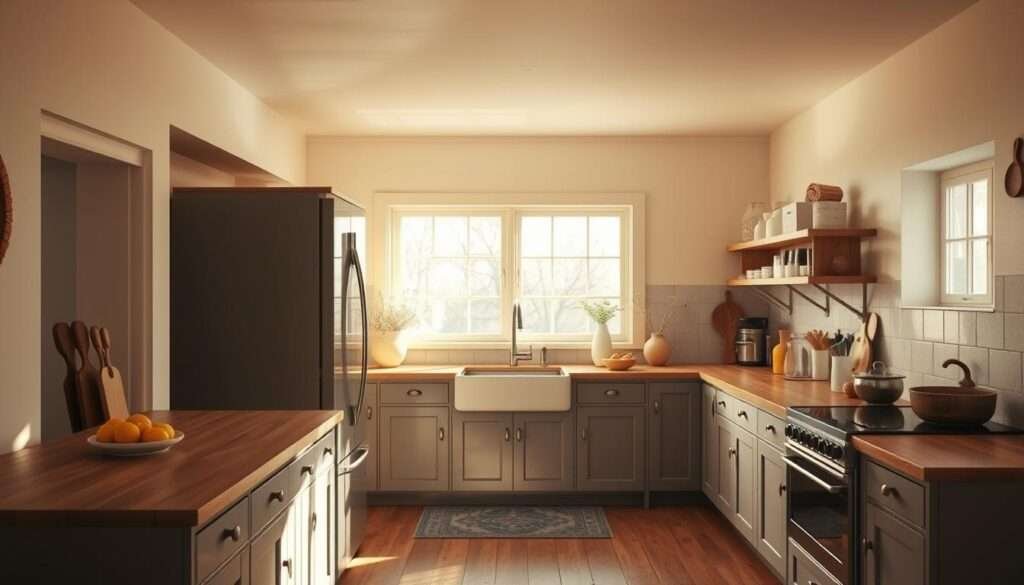
Best Paint Colors for Walls and Cabinets
For walls, Farrow & Ball’s “All White” is my top choice. Unlike clinical bright whites, it has a whisper of warmth that keeps space feeling welcoming. Pair it with Benjamin Moore’s “Mountain Peak White” for cabinetry—a versatile shade that adapts to natural light.
Testing undertones is crucial. North-facing rooms need yellower hues to combat gray light, while south-facing spaces can handle cooler tones. I swatched five greens for a client’s lower cabinets—Benjamin Moore’s “October Mist” won for its earthy balance.
Adding Pops of Color Without Overwhelm
Follow this formula: 70% neutrals, 20% mid-tones (like sage or slate), and 10% bold accents. Designer Heather Taylor nails this with sunflower-yellow textiles that pop against creamy walls. For a playful touch, Bambi Costanzo painted her dishwasher panel a soft blue—proof that even appliances can join the fun.
- Color zones: Define areas in open layouts with a muted backsplash or rug.
- Sample pots: Use them for drawer interiors—a budget-friendly surprise.
- Timeless vs. trendy: Save bold shades for removable items (curtains, art).
Last month, I matched soapstone counters to a wall color by holding samples at different times of day. The winner? A gray-beige that shifted from taupe to soft charcoal. It’s those subtle choices that create harmony.
3. Incorporate Reclaimed Wood for Rustic Character
Reclaimed wood carries stories in its grain—each knot and nail hole whispers history. When I installed a barn beam above my stove, the room instantly gained warmth no new material could replicate. This isn’t just about aesthetics; it’s about weaving the past into your daily life.
Creative Ways to Use Reclaimed Timber
From structural accents to subtle details, reclaimed wood adds unmatched personality. Designer Helen Norman layered three-tier shelving with varying wood tones, proving even small touches create depth. For a bold statement, Ken Pursley paired oak floors with a stained pine ceiling—a contrast that feels organic.
Consider these unexpected applications: – Range hood covers with factory-floor planks – Drawer fronts made from river-recovered timber – Floating shelves using barn wood with original paint flecks
Finding Authentic Materials
Salvage yards are treasure troves, but big-box stores like Home Depot now offer options like True Bead Wainscot Paneling. For my pantry, I sourced 100-year-old pine from a Pennsylvania dairy barn—half the cost of new wood. Always test for lead paint and check for insect damage before bringing pieces indoors.
| Type | Source | Best For |
|---|---|---|
| Barn wood | Demolition sales | Beams, accent walls |
| Factory planks | Industrial reclaimers | Countertops, islands |
If authentic materials aren’t feasible, wire-brush new pine and stain with coffee grounds for instant age. But as I learned restoring a 1920s butcher block, nothing beats the authentic design of wood that’s already lived.
4. Install Open Shelving for a Lived-In Look
The moment I removed my upper cabinets, the room breathed—suddenly airy and full of possibilities. Open shelving isn’t just storage; it’s a canvas for your daily rituals and favorite pieces. Designer Helen Norman taught me that even mismatched ceramics tell a story when grouped intentionally.
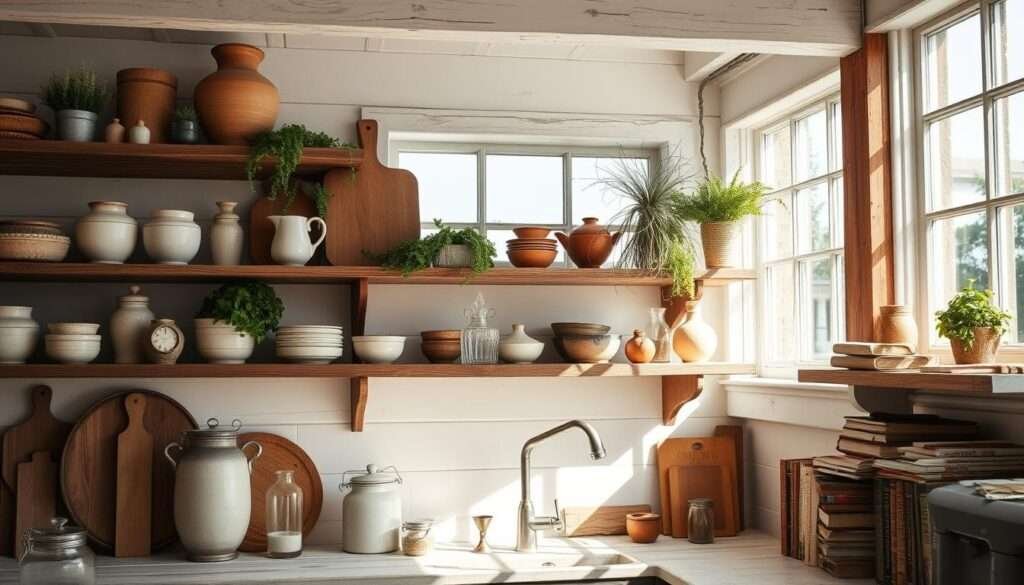
Styling Tips for Open Shelves
Balance is key. Jean Hanff Korelitz arranges her ironstone collection by color—cream pitchers next to slate-gray bowls. Follow her “3-2-1” rule: 3 stacks (books, plates), 2 leaning (cutting boards, art), and 1 plant for life.
My regret? Overcrowding shelves with trinkets. Now, I leave 30% empty space to let items shine. For spacing, measure the height of your tallest pitcher and add 2 inches between shelves.
Essential Items to Display
Meta Coleman’s pantry system proves function and beauty coexist. Her woven baskets hide snacks, while glass jars showcase grains. Here’s what belongs on your shelves:
- Ironstone pitchers: Timeless and practical for fresh herbs.
- Wooden cutting boards: Lean them against the wall for texture.
- Vintage scales: Adds a nostalgic accent.
- Linen napkins: Folded in stacks to keep space feeling soft.
| Bracket Type | Weight Limit | Best For |
|---|---|---|
| Floating | 15 lbs | Light ceramics, books |
| Industrial Pipe | 50 lbs | Cast iron, heavy dishes |
For childproofing, anchor lower shelves with bins or use a DIY plate rack (dowels + wood glue). Rotate decor seasonally—a pumpkin in fall, mason jars in summer—to refresh without overhaul.
5. Choose a Classic Farmhouse Sink
The first time I washed dishes in an apron-front sink, I realized how much deeper design choices impact daily routines. This style isn’t just about looks—it’s about creating a workspace that feels both timeless and effortless.
Apron-Front Sinks: Materials and Styles
Fireclay vs. cast iron was my biggest debate. Fireclay (like Whitehaus’s 30″ model) resists chips and stains, while cast iron offers vintage charm but requires more work to maintain. For small spaces, a 24″ width works, but taller users should opt for 30″+.
Heather Taylor’s skirted sink proves creativity thrives within limits. Her linen curtain softens the base, adding texture without sacrificing function. Consider these materials:
- Fireclay: Durable, non-porous (ideal for concrete countertops).
- Cast iron: Heavyweight, classic enamel finish.
- Stainless steel: Budget-friendly for rentals; pair with cladding kits.
Pairing with the Perfect Faucet
An unlaquered brass bridge faucet elevates the sink’s charm. Gooseneck designs suit deep basins, while bridge styles complement white cabinetry. Pro tip: Match the sink’s undertones—warm brass for cream finishes, polished nickel for gray.
| Faucet Type | Best For | Maintenance |
|---|---|---|
| Gooseneck | Deep sinks, filling pots | Wipe water spots weekly |
| Bridge | Traditional layouts | Use wax for patina |
Unexpected perk? My sink’s depth doubles as a baby bathtub. For rentals, adhesive panels mimic apron-front charm without permanent changes. Every choice here weaves into your home’s story.
6. Add Vintage-Inspired Lighting
Lighting transformed my space from functional to magical—like adding fireflies to a summer night. The right fixture doesn’t just brighten; it sets the mood, weaving personality into every corner.
Pendant Lights and Chandeliers That Tell a Story
Visual Comfort’s “Vendome” sconce became my obsession—its aged brass finish felt like it belonged in a Parisian café. For drama, a Murano glass chandelier (found at an estate sale) became the room’s jewel. Christina Salway’s scalloped pendant proves even small fixtures make a statement.
Five styles to consider:
- Schoolhouse pendants: Milk glass shades for a nostalgic glow.
- Industrial fixtures: Galvanized metal suits modern-vintage blends.
- Tole chandeliers: Floral motifs soften rustic beams.
Mixing Metals Like a Pro
Two finishes max—brass sconces with iron pendants—keep the look curated. My formula: 70% primary metal (e.g., brushed nickel), 30% accent (e.g., copper). For safety, always rewire antique fixtures with UL-certified parts and use warm LED bulbs (2700K) to mimic candlelight.
Unexpected tip? Hang a galvanized arm sconce above your window. It frames the view while adding ambient lighting. For budget finds, scour architectural salvage shops—my $20 factory pendant now anchors the breakfast nook.
Explore more kitchen lighting ideas to blend function and charm.
7. Create a Cozy Breakfast Nook
Morning light filtering through lace curtains transformed my cramped corner into a cherished spot for coffee and conversation. This small breakfast nook became where my family gathers daily—proof that thoughtful design fosters connection.
Small-space seating solutions
Maribeth Jones taught me the power of performance fabric when she upholstered her banquette in stain-resistant linen. For tight areas, consider these space-saving ideas:
- Built-in banquettes: 18″ seat depth with 4″ cushions (my first was too shallow)
- Fold-down tables: Wall-mounted leaves save floor space when not in use
- Under-seat storage: Woven baskets hold linens and seasonal decor
Erica Harrison’s walnut table shows how to age new wood naturally. She rubbed coffee grounds into the grain—a trick that saved hundreds on “distressed” furniture.
Table and chair ideas for cottage charm
Mismatched seating creates character. I paired a bentwood chair with ladderbacks for eclectic charm. Follow these tips to keep space feeling cohesive:
| Element | Recommendation |
|---|---|
| Table height | 28″-30″ for standard chairs |
| Pendant lighting | Hang 30″-36″ above table surface |
For holiday magic, Bambi Costanzo switches her skirted tablecloth seasonally—gingham for summer, plaid for winter. Discover more small-space solutions that maximize every inch.
What began as an awkward corner is now my favorite part of our home. The right layout turns even the smallest area into a welcoming retreat.
8. Use Beadboard Paneling for Cottage Charm
Running my fingers along the grooved surface, I realized beadboard paneling adds texture without overwhelming a room. Its vertical lines create height, while the subtle shadows play with light—perfect for spaces that need warmth.
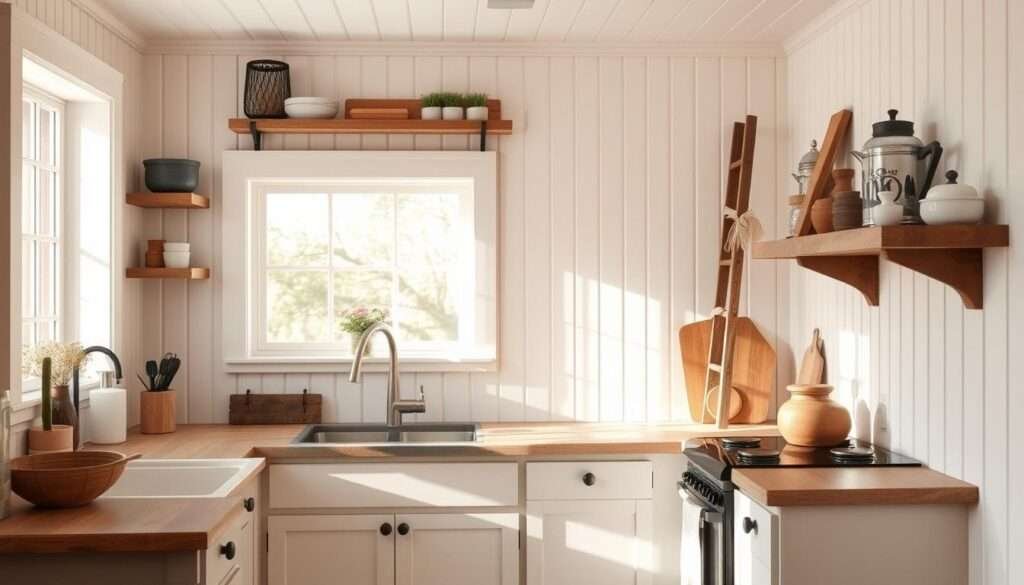
Where to Install for Maximum Impact
Walls are classic, but ceilings and islands surprise. Designer Christina Salway wrapped her island in beadboard, pairing it with green checkerboard tile for contrast. Key zones:
- Full-height walls: Elongates small rooms (use Home Depot’s True Bead Wainscot for easy cuts).
- Ceilings: Adds cottage charm to vaulted spaces—paint it sky blue for a porch-like feel.
- Islands: Bambi Costanzo’s DIY dry sink conversion proves it grounds freestanding pieces.
Painting Techniques That Elevate Texture
Dark hues accentuate grooves. I used design trick: semi-gloss navy below the chair rail, matte white above. For durability, choose high-gloss finishes in kid-friendly areas. Historic pairings like black and cream add farmhouse style authenticity.
| Application | Cost per Sq Ft | Skill Level |
|---|---|---|
| Wainscotting | $1.50–$3 | Beginner |
| Ceiling | $2–$4 | Intermediate |
Pro tip: Repair damaged panels with wood filler and a razor blade. For open shelves, align the beadboard’s grooves with shelf edges—it’s those details that create cohesion.
9. Decorate with Timeless Farmhouse Accessories
A chipped ironstone pitcher on my shelf caught the morning light, its imperfections telling stories of generations past. These pieces aren’t just decor—they’re the soul of a farmhouse kitchen, blending history with everyday life.
Must-Have Decor Items
Jean Hanff Korelitz’s ironstone collection taught me the power of display. Her cream pitchers and speckled bowls create rhythm when grouped in odd numbers. Start with these essentials:
- Ironstone: Look for “flow blue” marks on the underside for authenticity.
- Woven baskets: Vary sizes—12″ for fruit, 18″ for blankets.
- Transferware plates: Hang them in a salon-style wall arrangement.
Heather Taylor’s linen curtains (55% flax, 45% cotton) prove textiles soften hard surfaces. For seasonal swaps, I rotate a single accent: a wheat wreath in fall, a terra-cotta vase in summer.
Finding Vintage Treasures
Bambi Costanzo’s Facebook Marketplace tip: search “estate sale leftovers” for underpriced gems. My favorite haunts:
| Source | Best For | Pro Tip |
|---|---|---|
| Local auctions | Large furniture | Preview lots online first |
| Salvage yards | Industrial pieces | Bring a magnet to test iron content |
For a DIY project, I transformed thrifted breadboards into floating shelves. Discover more modern farmhouse kitchen decor ideas to layer personality into your space.
Every scratch and stain on these vintage finds adds to their charm—proof that beauty thrives in the imperfect.
10. Opt for Hardwood Floors with Patina
My bare feet recognized good hardwood before my eyes did—that perfect balance of smooth and textured. Unlike sterile laminates, these floors whispered stories through their knots and grain patterns. Ken Pursley’s signature oak floors showed me how the right wood can anchor an entire room’s aesthetic.
Country Living’s “nicks welcomed” philosophy changed my perspective. What I once saw as damage became evidence of a life well-lived. Now, I choose materials that age gracefully rather than fight inevitable character marks.
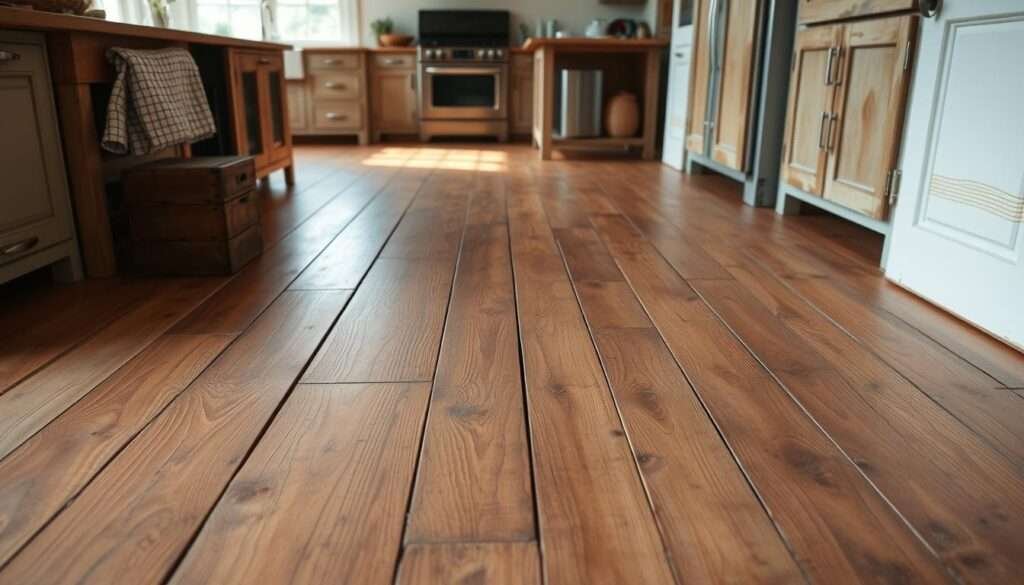
Choosing the right wood species and finish
My refinishing disaster taught me species matters. Sanding pine too aggressively left permanent swirl marks—a mistake oak’s hardness prevents. Ken Pursley’s go-to combo: white oak with a matte water-based polyurethane that lets grain shine.
| Species | Janka Hardness | Best Finish |
|---|---|---|
| White Oak | 1360 | Matte polyurethane |
| Hickory | 1820 | Oil-modified urethane |
| Pine | 690 | Wax or tung oil |
For new planks needing instant character, I drag chains in controlled patterns before staining. Historic 8″-wide boards create authenticity, while modern 5″ options work in tighter budgets.
How to maintain the "lived-in" look
Bambi Costanzo layers vintage rugs to keep space feeling cozy without hiding floors. Her formula: 5’x8′ rug under dining table with 2′ perimeter clearance. For high-traffic areas, I recoat every 3 years with a single polyurethane layer.
Pet owners should choose aluminum oxide finishes—they resist scratches better than oil-based options. My golden retriever’s nails barely leave marks on my treated hickory. Transition strips between rooms prevent height differences from becoming tripping hazards.
When restoring original floors, test lead content first. Sometimes, like in my 1920s home, replacement boards with hand-scraped edges blend better than aggressive sanding. The goal isn’t perfection—it’s harmony.
11. Mix Modern and Vintage Appliances
The hum of my new retro refrigerator made me pause—this wasn’t just an appliance, but a statement piece blending past and present. Achieving this balance requires strategic choices where form meets function without sacrificing either.
Retro Meets Reliable
My Smeg FAB32 dilemma taught me color matters. While the pastel pink was charming, the pro-style Hallman Gas Range’s dual fuel system won for serious cooking. Key considerations when mixing eras:
- Performance first: Hallman’s 18K BTU burners sear steaks while maintaining vintage aesthetics
- Integrated tech: Bosch’s panel-ready dishwashers hide behind cabinetry but offer smart cycle options
- Cost analysis: Retro fridges cost 2-3x more than standard models—budget for compressor replacements
Seamless Modern Conveniences
Disguising my vent hood with reclaimed wood maintained the farmhouse vibe. For those wanting hidden tech:
| Solution | Brand Example | Installation Tip |
|---|---|---|
| Cabinet-front fridge | Sub-Zero ICBID360R | Align panels with existing cabinetry |
| Appliance garage | IKEA SEKTION | Use tambour doors for small spaces |
Smart features can coexist with vintage design. My Hallman range pairs with a Wi-Fi meat thermometer—proof that nostalgia doesn’t mean sacrificing precision. Always check warranty terms; some retro brands offer only 1-year coverage compared to standard 5-year plans.
Final tip? Mix stainless steel with colored pieces. A cobalt blue Smeg pops against my graphite countertop, creating focal points without overwhelming the kitchen’s flow.
12. Personalize with Handmade and Heirloom Pieces
Turning family heirlooms into functional decor brought warmth to my space in ways store-bought items never could. These pieces carry stories that mass-produced items can’t replicate, adding layers of meaning to your home.
Honoring Family History
My grandmother’s recipe box became my favorite design element when I framed her handwritten cards under glass. The ink smudges where she wiped floury fingers made them feel alive. Try these ideas to showcase heritage:
- Transfer recipes onto tea towels using iron-on transfers—the perfect way to use them daily
- Display heirloom china on Bambi Costanzo’s DIY plate rack (dowels + sanded pine)
- Frame vintage seed packets as botanical art near windows
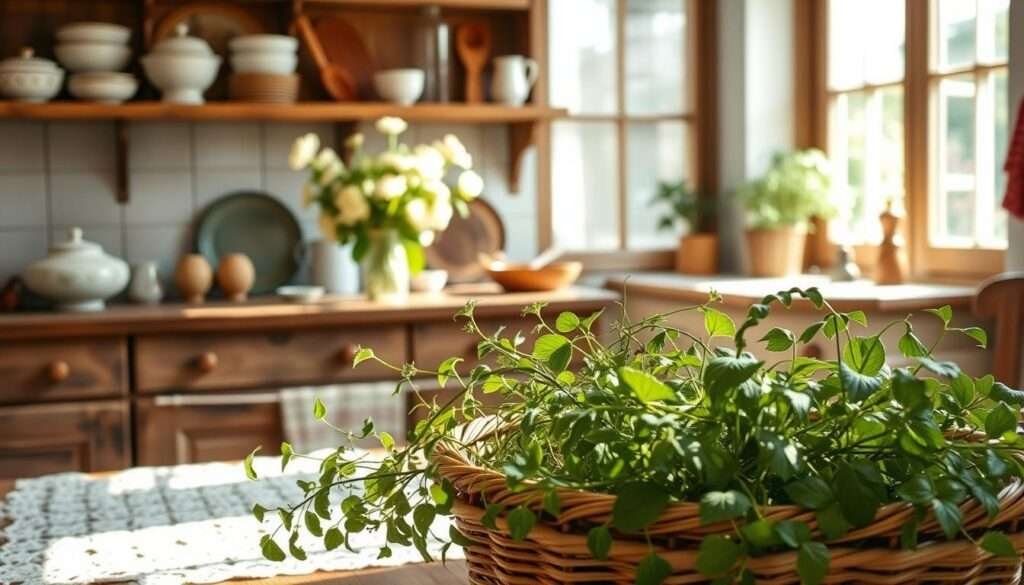
Creative DIY Touches
Fifi O’Neill’s burlap skirt tutorial transformed my plain sink base into a textural focal point. For quick projects that add personality:
- Engrave cutting boards with family initials using a wood burner
- Stencil floor cloths with folk patterns using outdoor paint
- Upcycle pallets into shelves for displaying pieces
Hand-painted terracotta pots became my herb containers, blending function with artistry. Discover more DIY room decor ideas to make every corner tell your unique story.
13. Let Your Farmhouse Cottage Kitchen Tell a Story
Every scratch on my grandmother’s rolling pin holds a memory, turning my space into a living scrapbook. Like Maribeth Jones’ breakfast nook, where pancake Sundays became family legends, your heart home thrives on these moments.
Christina Salway taught me to frame views like art—hang herbs by the window or display Jean Hanff Korelitz’s ironstone where light dances. Rotate kids’ art with seasons, or preserve a vintage mixer as a working heirloom.
Imperfections add personality. A chipped jug from flea markets or a travel souvenir on open shelves makes the design yours. For more rustic decor ideas, blend textures and memories. After all, the best spaces don’t just look good—they feel like home.
